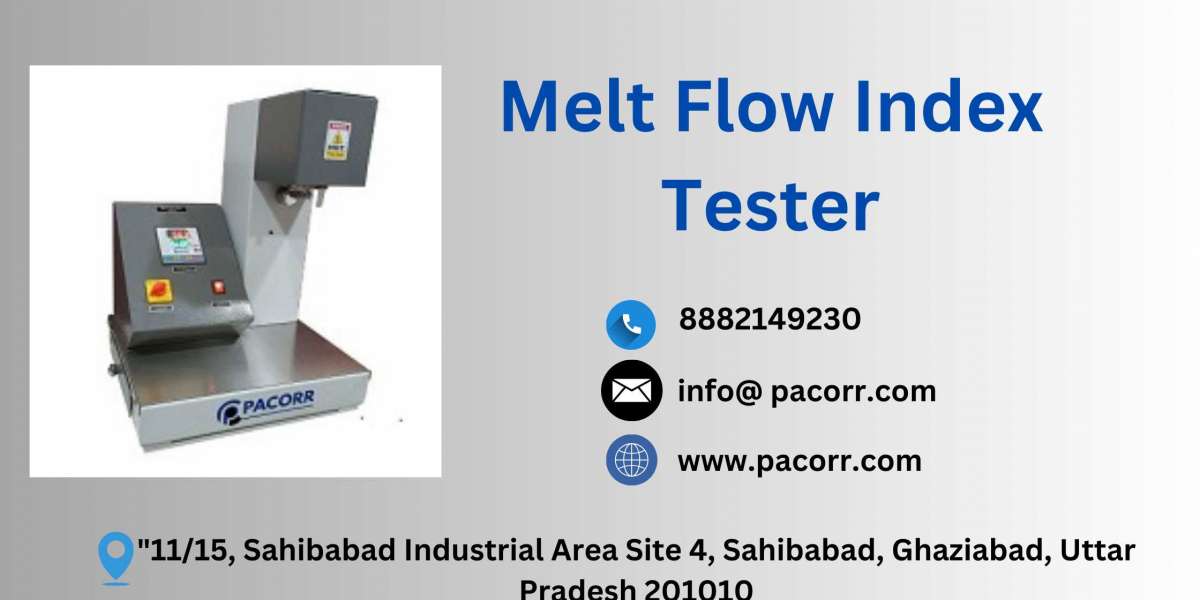Introduction
In the world of polymer manufacturing, maintaining product quality and consistency is paramount. One critical tool that helps manufacturers achieve this is the Melt Flow Index Tester (MFI Tester). This sophisticated instrument measures the melt flow rate of thermoplastic polymers, providing essential data that influences production processes and quality control. In this article, we will delve into the significance, working principles, and applications of the Melt Flow Index Tester.
What is a Melt Flow Index Tester?
A Melt Flow Index Testing is a device used to determine the flow characteristics of thermoplastic polymers under specific conditions. The melt flow index (MFI) is a measure of the ease of flow of the melted material, which is crucial for understanding its processing behavior and end-use performance. By measuring the MFI, manufacturers can ensure that their materials meet required specifications, leading to consistent and high-quality products
Importance of Melt Flow Index in Polymer Manufacturing
- Quality Control: The MFI provides insights into the viscosity and flow properties of polymers. Consistent MFI values indicate stable material properties, ensuring uniformity in the final product.
- Process Optimization: By understanding the flow behavior of polymers, manufacturers can optimize processing conditions such as temperature, pressure, and extrusion speed, leading to more efficient production.
- Material Selection: The MFI helps in selecting the right material for specific applications. Different applications require polymers with varying flow characteristics, and the MFI aids in making informed choices.
- Compliance and Standards: Many industries have strict regulations regarding the properties of polymer materials. The MFI test ensures compliance with industry standards and customer specifications.
How Does a Melt Flow Index Tester Work?
The Melt Flow Tester operates on a simple yet precise principle. Here’s a step-by-step overview of its working:
- Sample Preparation: A small sample of the polymer is prepared and placed in the heating chamber of the tester.
- Heating: The sample is heated to a specified temperature, causing it to melt.
- Extrusion: A specified weight (load) is placed on the melted polymer, forcing it to flow through a narrow orifice.
- Measurement: The amount of polymer that extrudes through the orifice in a given time (usually 10 minutes) is collected and weighed. This weight is the melt flow rate, typically expressed in grams per 10 minutes (g/10 min).
Applications of Melt Flow Index Testing
The Melt Flow Index Tester finds applications across various industries, including:
- Plastics Manufacturing: Ensuring consistent quality and performance of plastic products such as films, pipes, and containers.
- Automotive Industry: Evaluating the flow properties of polymers used in automotive components, ensuring durability and performance.
- Packaging Industry: Testing materials for packaging solutions to ensure they meet the required standards for strength and flexibility.
- Medical Devices: Ensuring the quality and consistency of polymers used in medical devices and equipment.
Conclusion
The Melt Flow Index Testing is an indispensable tool in the polymer manufacturing industry. Its ability to provide accurate and reliable data on the flow properties of thermoplastic polymers ensures that manufacturers can maintain high standards of quality and consistency. By investing in MFI testing, companies can optimize their production processes, meet regulatory requirements, and deliver superior products to their customers. Understanding and utilizing this crucial testing instrument is a step towards achieving excellence in polymer manufacturing.
FAQ: Melt Flow Index Tester
- What is a Melt Flow Index Tester?
A Melt Flow Index Tester is an instrument used to measure the melt flow rate of thermoplastic polymers. It determines the ease of flow of the melted material under specific conditions, providing critical data for quality control and process optimization in polymer manufacturing.
- Why is Melt Flow Index important in polymer manufacturing?
The Melt Flow Index (MFI) is crucial for several reasons:
- Quality Control: Ensures consistent material properties and uniformity in the final product.
- Process Optimization: Helps in optimizing processing conditions for efficient production.
- Material Selection: Assists in selecting the right polymer for specific applications.
- Compliance and Standards: Ensures compliance with industry standards and customer specifications.
- How does a Melt Flow Index Tester work?
The tester works by heating a polymer sample to a specified temperature, applying a specified load to the melted polymer, and forcing it through a narrow orifice. The amount of polymer extruded in a given time (usually 10 minutes) is collected and weighed, which is then expressed as the melt flow rate in grams per 10 minutes (g/10 min).
- What materials can be tested with a Melt Flow Index Tester?
Thermoplastic polymers, including polyethylene, polypropylene, polystyrene, and various other plastics, can be tested using a Melt Flow Tester. These materials are commonly used in industries such as automotive, packaging, medical devices, and general plastic manufacturing.
- What are the standard conditions for Melt Flow Index testing?
The standard conditions for MFI testing typically involve a specific temperature and a specified load, as defined by industry standards such as ASTM D1238 and ISO 1133. The exact conditions depend on the type of polymer being tested.
- How often should the Melt Flow Index Tester be calibrated?
Calibration frequency depends on the usage and specific industry requirements. However, it is generally recommended to calibrate the tester at least once a year to ensure accurate and reliable results.
- Can Melt Flow Index testing be automated?
Yes, modern Melt Flow Index Testers often come with automated features, including automatic sample cutting, digital measurement, and data logging, which enhance accuracy and ease of use.
- What are the limitations of Melt Flow Index testing?
While MFI testing provides valuable data on the flow properties of polymers, it does not give information about the mechanical properties or the molecular weight distribution of the material. Additional tests may be required for a comprehensive analysis of polymer properties.
- How does MFI relate to the processing of polymers?
The Melt Flow Index gives an indication of how a polymer will behave during processing. A higher MFI suggests that the material flows more easily, which can be beneficial for certain processes like injection molding. Conversely, a lower MFI indicates a more viscous material, which may be suitable for applications requiring higher strength.
- Can different MFI values affect the end-use performance of polymer products?
Yes, different MFI values can significantly impact the performance characteristics of polymer products. For example, a polymer with a high MFI may produce a more flexible and less durable product, while a lower MFI may result in a stronger, more rigid product. Manufacturers must choose the appropriate MFI based on the intended application of the polymer product.
- What safety precautions should be taken while using a Melt Flow Index Tester?
- Wear Protective Gear: Use gloves and safety goggles to protect against high temperatures.
- Follow Manufacturer’s Instructions: Adhere to the operating manual and safety guidelines provided by the manufacturer.
- Ensure Proper Ventilation: Operate the tester in a well-ventilated area to avoid inhaling any fumes released during the testing process.
- Regular Maintenance: Keep the equipment well-maintained and calibrated to ensure safe and accurate operation.







